 Richard Sharpe and the Invasion of France, June to November 1813. Major Richard Sharpe,s men were in mortal
Richard Sharpe and the Invasion of France, June to November 1813. Major Richard Sharpe,s men were in mortal  This is too much for Sharpe to bear, especially since his regiment was distinguished for capturing the first eagle insigne from a French flag in the war against Napoleon. Accompanied by his faithful Irish giant Sergeant Harper, Sharpe sails to England to find out for himself the best way to snatch his regiment from the jaws of bureaucracy. A companion regiment stationed in England, from which he had hoped to draw troops, suddenly doesn't exist - except on paper. Everywhere that Sharpe hunts for it proves a blind alley. Somebody is carrying on a tremendous cover up and milking the War Office for gold to support a literally invisible regiment. To find out where this hidden pool of troops might be, Sharpe and Harper strip themselves of their uniforms and pass themselves off as old soldiers ready to reenlist in the missing regiment. A recruiting sergeant, in a dreadfully oppressive scene, indeed signs them up along with other recruits and ships them off to boot camp, This turns out to be a hidden mudhole on Foulness island,
This is too much for Sharpe to bear, especially since his regiment was distinguished for capturing the first eagle insigne from a French flag in the war against Napoleon. Accompanied by his faithful Irish giant Sergeant Harper, Sharpe sails to England to find out for himself the best way to snatch his regiment from the jaws of bureaucracy. A companion regiment stationed in England, from which he had hoped to draw troops, suddenly doesn't exist - except on paper. Everywhere that Sharpe hunts for it proves a blind alley. Somebody is carrying on a tremendous cover up and milking the War Office for gold to support a literally invisible regiment. To find out where this hidden pool of troops might be, Sharpe and Harper strip themselves of their uniforms and pass themselves off as old soldiers ready to reenlist in the missing regiment. A recruiting sergeant, in a dreadfully oppressive scene, indeed signs them up along with other recruits and ships them off to boot camp, This turns out to be a hidden mudhole on Foulness island,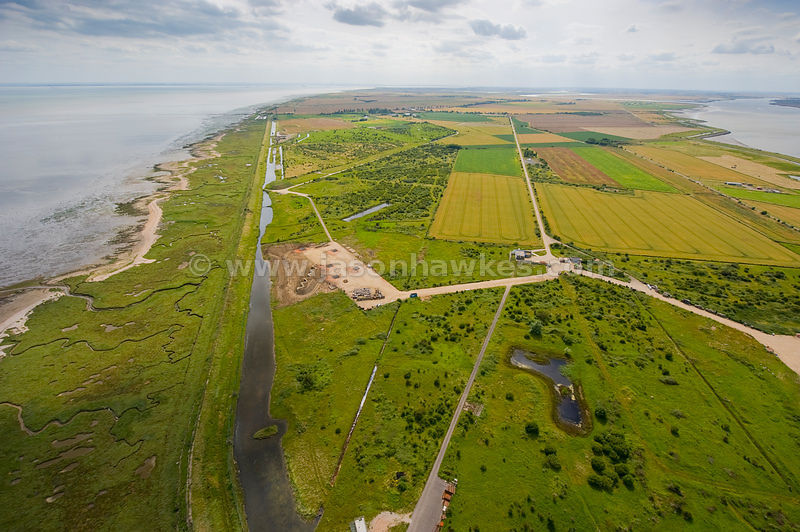 where Sharpe and Harper go through weeks of brutal training as recruits. Eventually, they escape from the island and pursue the trail of graft into the highest levels of the court before returning to their regiment with the needed troops and gearing up for the invasion of France. Livelier than usual, in fact quite original in that Sharpe gives up his command and finds himself in the foulest, pest-ridden depths of army life.
where Sharpe and Harper go through weeks of brutal training as recruits. Eventually, they escape from the island and pursue the trail of graft into the highest levels of the court before returning to their regiment with the needed troops and gearing up for the invasion of France. Livelier than usual, in fact quite original in that Sharpe gives up his command and finds himself in the foulest, pest-ridden depths of army life. 
From 1855, the Shoebury Sands, which are a continuation of the Maplin Sands to the south of the island, had been used as an artillery testing site, and the War Office sought to extend this at the end of the 19th century, by buying the island and its offshore sands, to act as a research and development centre for new weapons. They bought some of the sands above Fisherman's Head in 1900, but the rest belonged to Alan Finch, the Lord of the Manor, and he refused to grant shooting rights over them. In 1912, the War Office also discovered that large areas of the sands were leased to tenants, who used them for fishing kiddles.
A kiddle was a large V-shaped or square net, which formed an enclosure in which fish were trapped as the tide receded.
Attempts to buy the lordship were also refused by Finch, but he died in 1914, and his half-brother Wilfred Henry Montgomery Finch sold it on 13 July 1915, resulting in the War Office owning around two-thirds of the island. They had also been buying any farms that were not part of the manor, and by the end of the First World War the only buildings which they did not own were the church and rectory, the school, and a mission hall at Courts End. They demolished the post mill 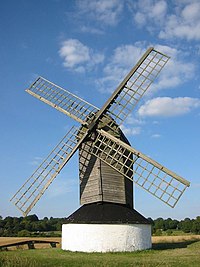 towards the beginning of the war, and the parish poor-house and a wooden lock-up which was located near the church were also demolished.
towards the beginning of the war, and the parish poor-house and a wooden lock-up which was located near the church were also demolished.
 towards the beginning of the war, and the parish poor-house and a wooden lock-up which was located near the church were also demolished.
towards the beginning of the war, and the parish poor-house and a wooden lock-up which was located near the church were also demolished.
Ian Yearsley, in Islands of Essex opens the chapter on Foulness with a portentous quote from James Wentworth Day who describes “…that strange island where no stranger is welcome, where all unknown faces are suspect…”.Our experience is rather the opposite, although, with a time-frame of only four hours, it would be hard to outstay your welcome. A tractor pulls up outside the centre, towing a contraption that is something between a bathing machine and a very small  railway carriage, out of which about a dozen people emerge. It turns out that they have just travelled the B
railway carriage, out of which about a dozen people emerge. It turns out that they have just travelled the B to get here, and we submit a couple of the guys to a friendly interrogation. It has taken them about an hour to travel from Wakering Stairs,
to get here, and we submit a couple of the guys to a friendly interrogation. It has taken them about an hour to travel from Wakering Stairs,  and they enthuse about the experience of travelling over the Maplin sands,
and they enthuse about the experience of travelling over the Maplin sands,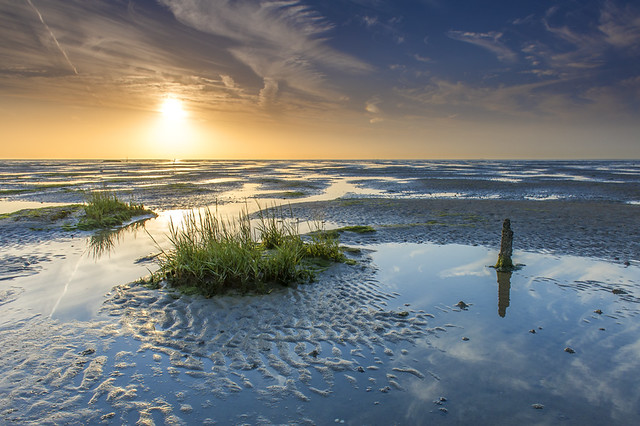 a mile or so from the shoreline.
a mile or so from the shoreline.
 to get here, and we submit a couple of the guys to a friendly interrogation. It has taken them about an hour to travel from Wakering Stairs,
to get here, and we submit a couple of the guys to a friendly interrogation. It has taken them about an hour to travel from Wakering Stairs,  a mile or so from the shoreline.
a mile or so from the shoreline.
We head back to the security gate, check out and turn on to the public road that leads to Wakering Stairs, the start of the Broomway. Having looked at many photos and film clips of the Broomway, the ramp to the seawall, with an empty watchtower next to it, feels familiar. A family is picnicking on the wall and when we reach the top of the ramp, the Maplin Sands shimmer before us, stretching out to where the Thames heads for the sea a couple of miles away, and beyond that, the Kent Coast, presumably Sheppey and Whitstable Bay.
the Kent Coast, presumably Sheppey and Whitstable Bay.
 the Kent Coast, presumably Sheppey and Whitstable Bay.
the Kent Coast, presumably Sheppey and Whitstable Bay.
We walk over the semi-made causeway, which peters out after a hundred yards or so. There are a couple of cyclists out on the mud ahead of us, and tractor tracks, presumably left by the vehicle we had met at Churchend, so we proceed with confidence. Sound behaves oddly. The voices of the people on the shore carry clearly and invisible geese honk from a distance over the mudflats. The best account of the Broomway that I have read appears in The Old Ways in which Macfarlane describes the ‘soft lunacy’ of the walk across the ‘mirror world’ of this seascape, and the lure of the horizon, with “as potent a pull upon the mind as a mountain’s summit”. He and his companion stray from the notional safety of the path and walk two miles out across the sands. We have come barely a half mile from the stairs, although Ebb Tide appears to be in thrall to the potent pull and has struck off a couple of hundred yards ahead of the four of us. The tide is due to be flowing in: Master F. notices some of the pools covering the sand have an incoming, trickling mini-current in them, and mindful of advice that the tide here can move faster than a person can run,and not being runners, we hail Ebb Tide and head for the shore.
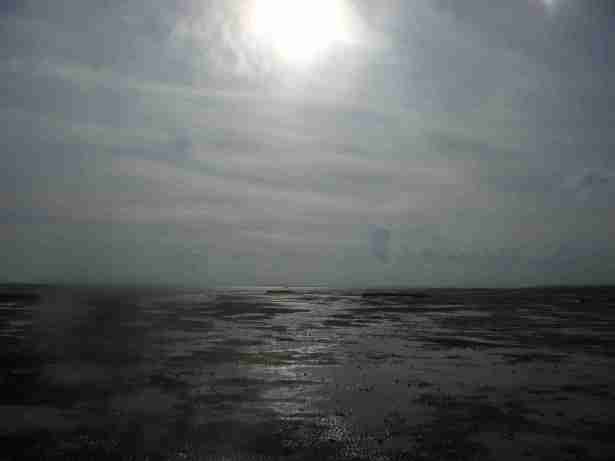
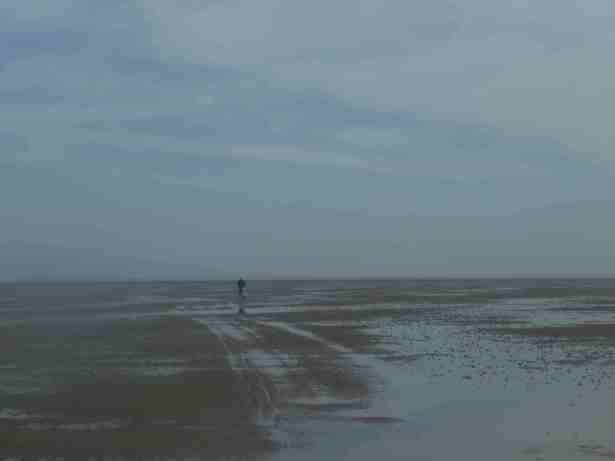

No comments:
Post a Comment